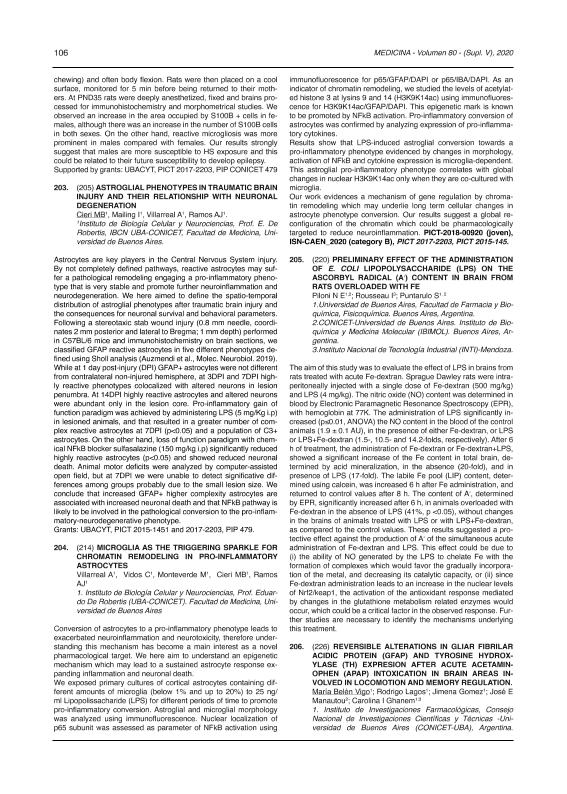Evento
Astroglial phenotypes in traumatic brain injury and their relationship with neuronal degeneration
Tipo del evento:
Reunión
Nombre del evento:
LXV Reunión anual de la Sociedad Argentina de Investigación Clínica; LXVIII Reunión anual de la Sociedad Argentina de Inmunología y Reunión Anual de la Asociación Argentina de Fisiología
Fecha del evento:
10/11/2020
Institución Organizadora:
Sociedad Argentina de Investigación Clínica;
Sociedad Argentina de Inmunología;
Asociación Argentina de Fisiología;
Título de la revista:
Medicina
Editorial:
Fundación Revista Medicina
ISSN:
0025-7680
Idioma:
Inglés
Clasificación temática:
Resumen
Astrocytes are key players in the Central Nervous System injury.By not completely defined pathways, reactive astrocytes may suffer a pathological remodeling engaging a pro-inflammatory phenotype that is very stable and promote further neuroinflammation andneurodegeneration. We here aimed to define the spatio-temporaldistribution of astroglial phenotypes after traumatic brain injury andthe consequences for neuronal survival and behavioral parameters.Following a stereotaxic stab wound injury (0.8 mm needle, coordinates 2 mm posterior and lateral to Bregma; 1 mm depth) performedin C57BL/6 mice and immunohistochemistry on brain sections, weclassified GFAP reactive astrocytes in five different phenotypes defined using Sholl analysis (Auzmendi et al., Molec. Neurobiol. 2019).While at 1 day post-injury (DPI) GFAP+ astrocytes were not differentfrom contralateral non-injured hemisphere, at 3DPI and 7DPI highly reactive phenotypes colocalized with altered neurons in lesionpenumbra. At 14DPI highly reactive astrocytes and altered neuronswere abundant only in the lesion core. Pro-inflammatory gain offunction paradigm was achieved by administering LPS (5 mg/Kg i.p)in lesioned animals, and that resulted in a greater number of complex reactive astrocytes at 7DPI (p<0.05) and a population of C3+astrocytes. On the other hand, loss of function paradigm with chemical NFkB blocker sulfasalazine (150 mg/kg i.p) significantly reducedhighly reactive astrocytes (p<0.05) and showed reduced neuronaldeath. Animal motor deficits were analyzed by computer-assistedopen field, but at 7DPI we were unable to detect significative differences among groups probably due to the small lesion size. Weconclude that increased GFAP+ higher complexity astrocytes areassociated with increased neuronal death and that NFkB pathway islikely to be involved in the pathological conversion to the pro-inflammatory-neurodegenerative phenotype.
Palabras clave:
ASTROCYTES
,
PHENOTYPES
,
TRAUMATIC BRAIN INJURY
Archivos asociados
Licencia
Identificadores
Colecciones
Eventos(IBCN)
Eventos de INST.DE BIOLO.CEL.Y NEURCS."PROF.E.DE ROBERTIS"
Eventos de INST.DE BIOLO.CEL.Y NEURCS."PROF.E.DE ROBERTIS"
Citación
Astroglial phenotypes in traumatic brain injury and their relationship with neuronal degeneration; LXV Reunión anual de la Sociedad Argentina de Investigación Clínica; LXVIII Reunión anual de la Sociedad Argentina de Inmunología y Reunión Anual de la Asociación Argentina de Fisiología; Argentina; 2020; 106-106
Compartir




